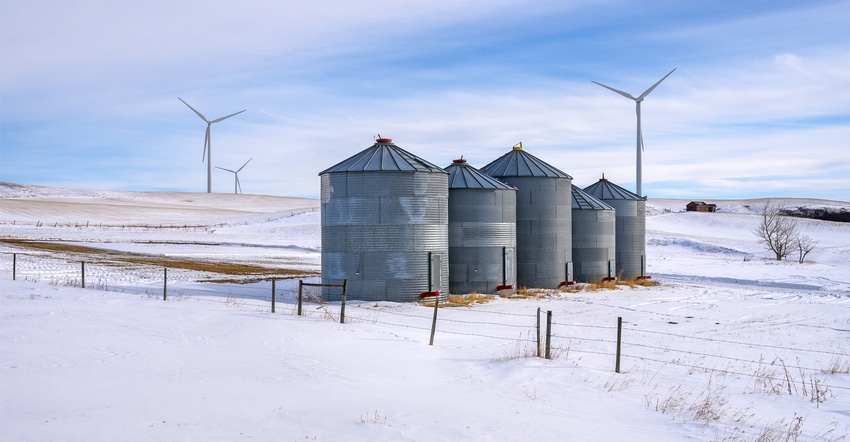March 4, 2022

Winter in the Dakotas can often be summarized as being windy and cold. If temperatures are forecasted as being well below freezing, it would probably be a good time to start thinking about turning your bin fan on to further cool any stored grain.
Aerating grain throughout the year is important for maintaining humidity and temperature throughout the bin; but aerating grain during the winter months is also important because of the colder temperatures and drier air. Cooling grain reduces the activity of stored grain insect pests and suppresses any mold growth that may otherwise occur.
Grain should be cooled to temperatures at or below 55 degrees F to reduce insect activity. If temperatures throughout the bin drop below this threshold, insect death should eventually occur due to their reduced feeding. The temperatures required to freeze and kill stored grain pests vary by species, but generally they range from 23 to −10 degrees. Most molds are suppressed at 40 degrees, except for penicillium molds, which require temperatures below 32 degrees.
Aerating may cause a small reduction in grain moisture with about 0.25% to 0.5% moisture being lost per aeration cycle, depending on factors such as air temperature and moisture.
For long-term storage, multiple aeration cycles may reduce grain by as much as 2%. However, due to low flow rates, the drying front within the bin moves fairly slowly, and most of the moisture reductions will occur in grain that is closest to the entrance of the forced air. Reducing the temperature of grain throughout the bin during the winter will help keep grain at a cooler temperature through spring and early summer.
Winter grain storage tips
Follow these tips to keep grain quality high:
Cover bin aeration fans when not in use. The fans essentially go through the chimney effect, where wind moves air into the fan and it travels upward, affecting the grain inside. Although this can be favorable during cold and dry periods, fans should be covered during snow events.
Allow air movement. Provide an inlet for air near the roof eave and outlet exhaust near the roof peak to allow warm air to exit the bin (much like the principles of an attic). Several vents at the same elevation can still allow heat to remain at the top of the bin without exhaust at the peak or roof exhaust fans. Without proper ventilation, condensation can occur.
Monitor grain weekly. Throughout grain storage, producers should check stored grain every week for storage temperature, insect infestations and mold growth. Grain temperature should be measured at several places along the walls of the bin, near the top surface and within the grain. Temperature sensors are useful; however, multiple readings are necessary to get an accurate picture of overall temperature.
Check on moisture levels. When using a moisture meter to check grain, be sure to warm up samples to room temperature in a sealed container for several hours before measuring.
Crop-specific tips
The following recommendations are from Ken Hellevang, professor in agricultural and biosystems engineering at North Dakota State University Extension:
Corn. The fan’s airflow rate should be at least 1 cubic foot per minute per bushel, and the initial grain moisture should not exceed 21%. Start the fan when the outdoor temperature averages 40 degrees.
Soybeans. Use an airflow rate of at least 1 cfm per bushel to naturally air-dry to 15% or 16% moisture. Start the fan when the outdoor temperature averages 40 degrees.
Wheat. Use an airflow rate of at least 0.75 cfm per bushel to naturally air-dry up to 17% moisture. Start drying when the outside air temperature averages 50 degrees.
Sunflowers. To naturally air-dry to 15% moisture, an airflow rate of 0.75 cfm per bushel is needed. The drying should start when outdoor temperatures average 40 degrees.
Source: South Dakota State University, which is responsible for the information provided and is wholly owned by the source. Informa Business Media and its subsidiaries aren't responsible for any of the content contained in this information asset.
You May Also Like




